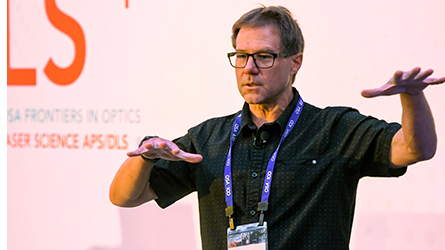From VR and AR to "Mixed Reality"
From VR and AR to "Mixed Reality"
Stewart Wills

Right now, virtual reality (VR) and augmented reality (AR) largely occupy different domains: VR seeks to immerse users in an entirely separate world, while AR overlays additional data, images and experiences onto the real one. But Scott McEldowney of Oculus Research, USA—who gave one of three “Visionary Speakers” keynotes that kicked off the Monday session of OSA Frontiers in Optics conference in Washington, D.C.—sees a future in which those strands will come together. Devices almost as lightweight as an ordinary pair of eyeglasses will someday “offer AR, and VR, and everything in-between,” said McEldowney. “And we’re going to wear them all day long.”
McEldowney, an optical engineer who has worked on both VR and AR imaging and display for Oculus and, earlier, for Microsoft on its Kinect and Hololens products, has no doubt that this “mixed reality” future is coming. But, he says, it’s likely to be many years away. And getting there, he told his audience, will require “many breakthroughs by the people in this room.”
Getting to a “socially acceptable” platform
McEldowney noted that VR is already making strides at capturing aspects of the real world and bringing it into the virtual one. That, he said, would “probably revolutionize a lot of the ways we work and play.” But according to McEldowney, VR, as it’s done today, can never produce a “go-anywhere, mixed-reality device” that is as “socially acceptable” as an ordinary, see-through pair of eyeglasses. And that level of social acceptability, he said, is “an absolute requirement for anything we’re going to wear in public.”
That means, he says, that the path to what McEldowney calls “full AR”—the mixed-reality future—will need to be via see-through AR glasses that are “light, comfortable, power efficient, stylish and socially acceptable.” And it’s a tall technical order. “It’s going to take five years, ten years, or even longer,” he said, “but eventually they will become a viable part of our everyday lives.”
Continue reading on the Optics & Photonics News Website. >
